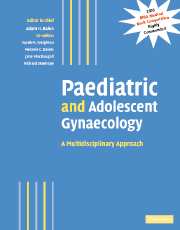Book contents
- Frontmatter
- Contents
- Contributors
- Preface
- Part I Normal development
- Part II Management of developmental abnormalities of the genital tract
- Part III Management of specific disorders
- 18 Disorders of growth and puberty
- 19 Turner's syndrome
- 20 Androgen insensitivity syndromes
- 21 Rokitansky syndrome and other Müllerian anomalies
- 22 The XY female
- 23 The gynaecology of the major genitourinary anomalies
- 24 Congenital adrenal hyperplasia
- 25 Long-term sequelae of genital surgery
- 26 Amenorrhoea
- 27 The polycystic ovary syndrome and adolescent women
- 28 Menstrual disorders in adolescent girls
- 29 Pelvic pain, ovarian cysts and endometriosis in adolescent girls
- 30 Premature ovarian failure and ovarian ageing
- 31 Gynaecological cancers in childhood
- 32 Late reproductive sequelae of treatment for childhood cancer
- 33 Preservation of fertility before cancer therapy
- 34 The management of infertility with surrogacy and egg donation
- 35 Dermatological conditions of the female genitalia
- 36 Vaginal discharge
- 37 Psychological gender development in individuals born with ambiguous genitalia
- 38 Eating disorders in adolescence
- 39 Nutritional amenorrhoea: long-term sequelae
- 40 How to set up a service: how to teach and train
- Index
- Plate section
- References
18 - Disorders of growth and puberty
from Part III - Management of specific disorders
Published online by Cambridge University Press: 04 May 2010
- Frontmatter
- Contents
- Contributors
- Preface
- Part I Normal development
- Part II Management of developmental abnormalities of the genital tract
- Part III Management of specific disorders
- 18 Disorders of growth and puberty
- 19 Turner's syndrome
- 20 Androgen insensitivity syndromes
- 21 Rokitansky syndrome and other Müllerian anomalies
- 22 The XY female
- 23 The gynaecology of the major genitourinary anomalies
- 24 Congenital adrenal hyperplasia
- 25 Long-term sequelae of genital surgery
- 26 Amenorrhoea
- 27 The polycystic ovary syndrome and adolescent women
- 28 Menstrual disorders in adolescent girls
- 29 Pelvic pain, ovarian cysts and endometriosis in adolescent girls
- 30 Premature ovarian failure and ovarian ageing
- 31 Gynaecological cancers in childhood
- 32 Late reproductive sequelae of treatment for childhood cancer
- 33 Preservation of fertility before cancer therapy
- 34 The management of infertility with surrogacy and egg donation
- 35 Dermatological conditions of the female genitalia
- 36 Vaginal discharge
- 37 Psychological gender development in individuals born with ambiguous genitalia
- 38 Eating disorders in adolescence
- 39 Nutritional amenorrhoea: long-term sequelae
- 40 How to set up a service: how to teach and train
- Index
- Plate section
- References
Summary
Introduction
Puberty is defined as the acquisition of secondary sexual characteristics associated with a growth spurt and resulting in the attainment of reproductive function. The endocrine events of puberty commence many years before the onset of phenotypic puberty (see Ch. 4). The onset of puberty is characterized by nocturnal luteinizing hormone (LH) release. It is a result both of increased pituitary sensitivity to gonadotrophin-releasing hormone (GnRH) caused by prolonged unopposed oestrogen exposure of the gonadotrophic cells and of gonadal hormone secretion. In boys, spermatogenesis is initiated at stage 3, and menarche in girls occurs during late puberty. Initial menstrual cycles are usually anovulatory, which is associated with irregular and often painful periods. Precocious puberty is defined as the development of sexual characteristics before the age of eight years in girls and nine years in boys. Delayed puberty is defined when there is no sign of puberty at the age of 13.4 years in girls and 14 years in boys (2SD above the mean of chronological age for the onset of puberty).
It is important to recognize the harmony of normal events (consonance) of puberty; when it is absent, an endocrine disorder should be suspected. The loss of consonance has been described as one of the first signs of an endocrine disease (e.g. hypothyroidism, Cushing's syndrome, gonadal dysgenesis), in the absence of more obvious manifestations (Stanhope et al., 1986).
Disorders of pubertal development
The classification of disorders of pubertal development are described in Table 18.1.
- Type
- Chapter
- Information
- Paediatric and Adolescent GynaecologyA Multidisciplinary Approach, pp. 231 - 241Publisher: Cambridge University PressPrint publication year: 2004



